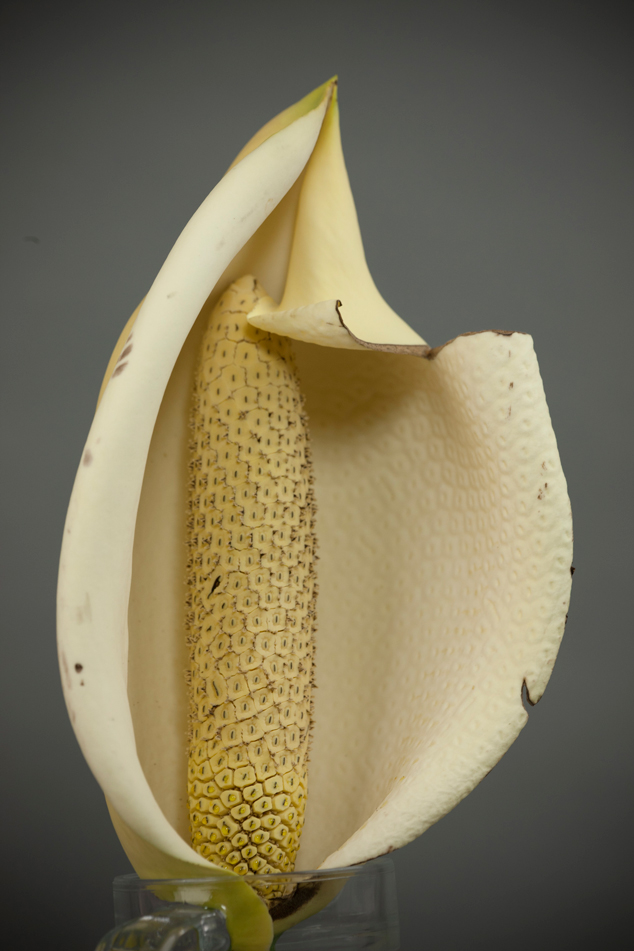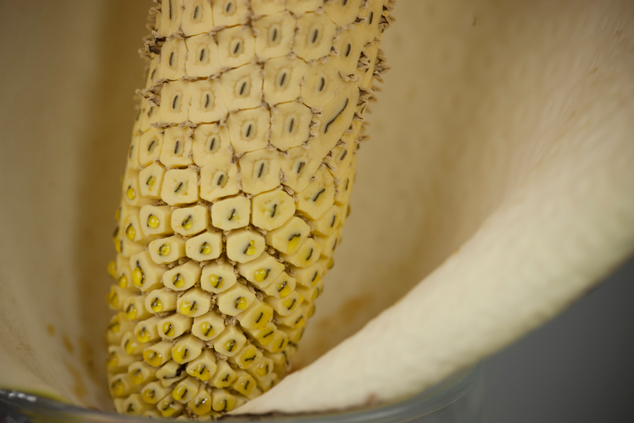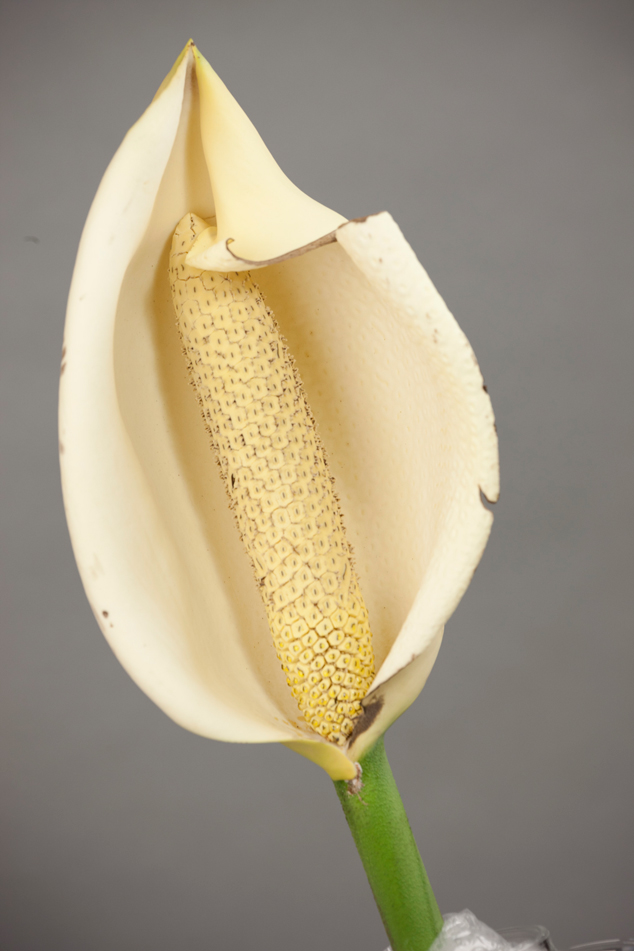Split leaf philodendron, Monstera deliciosa
A thick stemmed climber with roots along the stem. Mature leaves are huge (80 cm long) dark green, rounded but with holes of various sizes and shapes. Flowers very small, in a spike, covered with a cream spadix. Fruits are hexagonal berries.
Monstera deliciosa leaves at FLAAR office in Guatemala, Photo by Daniela da Costa.
Monstera deliciosa spike covered with a cream spadix, notice inside the spike the yellow small flowers.
Monstera deliciosa spike covered with a cream spadix, photo by Sofia Monzon.
Monstera deliciosa is a common house plant and a common garden plant throughout Guatemala. I am at 1500 meters elevation and my Monstera deliciosa is very healthy and happy. Unfortunately it’s deep in the shade and has not bloomed during the four years that it has been growing. So to get the photographs that we include here, I had to go to Coban, Alta Verapaz. However this plant is so common it is just a matter of happenstance whether you can find someone who is closer who has the same species out in the sun.
A well known ornamental used both out and indorrs. Mature fruits are edible but green fruits are full of calcium oxalate crystals that can cause allergies. Flowers are pollinated by Trigona spp. bees.
Nomenclature for Split leaf philodendron, Monstera deliciosa
It is confusing whether Split leaf philodendron is an acceptable name any more for Monstera deliciosa. I myself have never heard the name ceriman, which is evidently the name given by Morton, since that is the source of the web pages of the Purdue university horticultural web site.
Edible parts
The erect spike is what you can eventually eat, after it has ripened. Since the spike has unpleasant chemicals in it when unripe, and since the plant in my own garden has never bloomed (even in four years), I have never tasted this plant.
The photographs here were taken in the Posada Monja Blanca, Coban, Alta Verapaz, Guatemala, Central America.
I have stayed at this hotel about once a year for five years. I have photographed this plant before but never saw the flowers blooming as they were this year in the first week of June.
Inmature spike of Monstera deliciosa in this stage the fruit is full of calcium oxalate crystals.
A close up of the inmature flowers and spike.
Medicinal properties
Since over 200 plants in Guatemala have claimed medicinal use, and as many of them are also toxic or irritants to people also, we carefully avoid doing studies of medicinal plants. We would be glad to undertake such studies, but would need to add chemists and specialists to our staff.
Roots can be used to make rope
Many of the vines which grow on trees, the roots of these vines can be used for rope or comparable utilitarian usage. You generally peel off the bark and make your cordage from a single piece.
Gardening
My Split leaf philodendron, Monstera deliciosa has never bloomed and grows slowly (but surely). Probably it has too much shade. This is one of my favorite plants.
We are at 1500 meters elevation and have an ample rainy season, though a rather harsh dry season too. However we water the garden during the dry season. So lack of water is not an issue with our plants. It Is in the soil; not in a pot.
I really am happy when tropical plants that I have always liked my entire life happen also to be indigenous to Mexico and/or Central America. And it is a double pleasure when the same plant is also edible and/or utilitarian.
Photography
Most photographs are grossly overexposed on the white, and too dark on the rest of the plant. The best example of really bad photographs can quickly be found. But good photographs are also available, such as in the (Chicago) Field Museum, plant guides.
I too had a tough time getting usable photos (since so much was in the shade but the white flower was burned out since it was in the sun).
So we asked permission of the owner of the hotel if we could take two of the flowers back to our office to photograph with soft fluourscent lighting in our photo studio.
If you like to photograph this kind of textured surface, also look for
- Anthurium cubense
- Anthurium lucens
- Anthurium silvigaudens
- Anthurium subcordatum
Monstera deliciosa photo at FLAAR studio, Photo by Sofia Monzon.
BIBLIOGRAPHY
As with other plants, probably 60% of what is on the Internet is copied, usually verbatim, from one site to another (usually with no attribution).
The horticultural web site of Purdue University is helpful. FAO publications tend to be useful on many plants (though I did not go to them for the monstera). House plants Wikia had helpful general information plus some useful photos (albeit typical botanical shots compared with photographs from The Field Museum which are really good).
www.hort.purdue.edu/newcrop/morton/ceriman.html
http://houseplants.wikia.com/wiki/Monstera_deliciosa
useful general info; some useful photos (albeit not spectacular).
Last update 12 August 2011.
First posted July 07, 2011.



















































































